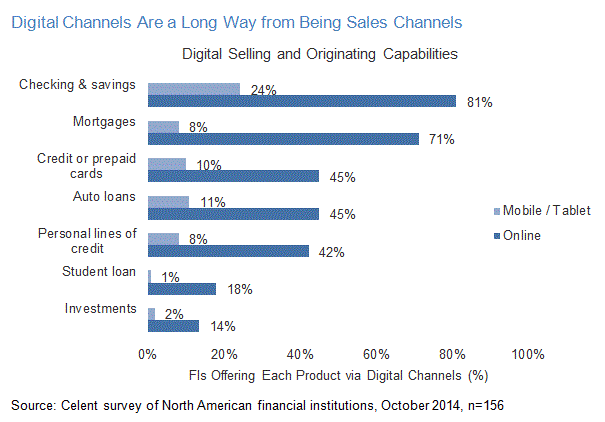Retail Banking Channel Systems in North America: The Quest for Omnichannel Continues
Abstract
Although digital engagement is where the industry may be headed, face-to-face engagement is where the industry remains.
Consumer preferences are on the move, and their seismic changes are forcing most banks to play catch-up. In the report Retail Banking Channel Systems in North America: The Quest for Omnichannel Continues, Celent offers a thorough analysis of omnichannel banking and where North American financial institutions are taking their channel systems. Following two previous biennial research efforts, the report draws upon multiple interviews among financial institutions and solution providers as well as a survey administered to 156 North American banks and credit unions during October 2014.
The most recent survey finds continued interest in branch transformation, but more banks and credit unions are playing digital channel catch-up as a first priority. Right alongside improving digital channel capabilities is the quest for omnichannel delivery. Banks consistently across the asset tiers hold omnichannel delivery as a matter of first importance, but there is great diversity of opinion of what “omnichannel” means. Insights from the research include:
- Nearly 40% of banks with assets over US$50 billion operate more than one branch technology environment, increasing the cost and complexity of much-needed technology initiatives.
- Barely a third of surveyed FIs leverage automated (paperless) account origination systems in the branch, and fewer have similar lending systems. These business processes need to be redesigned if FIs are to realize the nimble, tablet-equipped, universal banker vision so many espouse.
- Three-quarters of surveyed institutions expect continued transaction migration of more than 5% per year, and nearly 40% expect transactions to leave the branch channel at twice that pace. Yet, a third of surveyed FIs expect no change in branch count over the next five years, while 40% expect a net add in branches. Just 25% of FIs forecast a decline in branch count.
- A growing number of institutions seek ways to engage customers online, but capability is lagging this ambition. Less than one in five FIs offer shopping coupons, discounts, or rewards programs online; fewer offer text or video chat options; and fewer still offer online appointment booking.
- The mobile/tablet channel remains transaction-focused, although only two-thirds of FIs offer account-to-account transfers, and less than one-third offer P2P payments. In terms of customer engagement, just one in five institutions deploy targeted marketing messages via the mobile channel, and fewer still offer even rudimentary personal financial management (PFM).
The result is that digital channels are a long way from being sales channels at most FIs, lacking even the capability to enroll new customers across many products.

“Banks have a great deal of work ahead of them to deliver a high-quality, low friction, and engaging customer experience across all delivery channels, while concurrently lowering the cost to serve,” says Bob Meara, a senior analyst with Celent’s Banking practice and author of the report. “Doing so is not optional, and most banks are worlds away from this objective.”
The report begins with an analysis of surveyed retail banking strategic priorities, the changing role of channels, and the importance of technology in realizing key priorities. The report then examines the current and likely future trends in branch, online, and mobile/tablet channel platforms based on an extensive survey of North American banks and credit unions conducted in October 2014.
This 72-page report contains two tables and 105 figures, including an extensive appendix detailing current and planned technology adoption across digital and branch channel systems.

